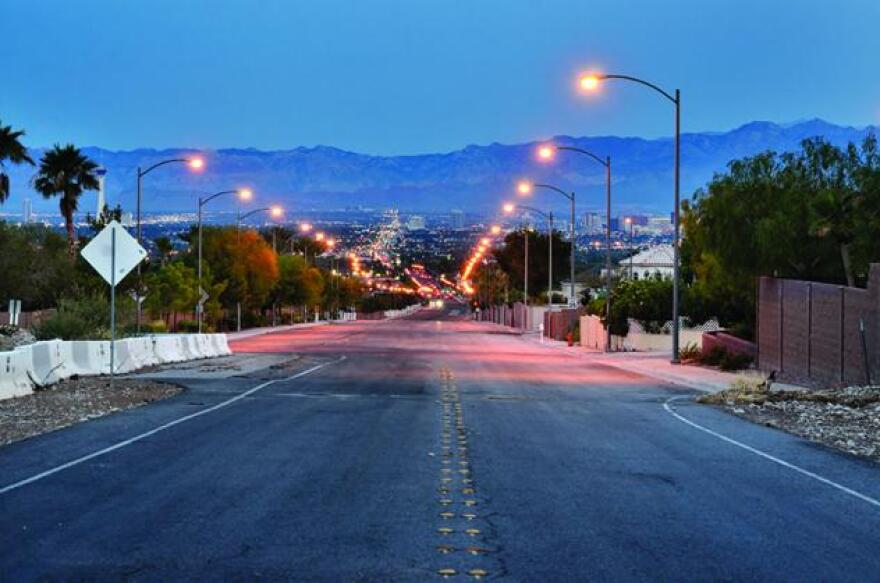Las Vegas City Council voted last week to explore the idea of a multibillion-dollar, 19-mile mass-transit system that a private company wants to develop for Charleston Boulevard.
During its Wednesday meeting, the council entered the city into an exclusive negotiating agreement with Axios Nevada, a company that represents investors interested in constructing and operating the system.
The company now has two years to figure out whether light rail or other high-capacity system makes sense, and how it would be built and paid for and run at a profit — without the use of tax dollars.
Longtime Nevada transportation figure Tom Skancke, a principal with Axios Nevada, told State of Nevada a transit line is a natural fit for the east-west thoroughfare.
“It makes sense to do the Charleston Boulevard corridor because it really is a huge arterial in the community that moves a lot of Strip employees from the eastern part of the valley to Las Vegas Boulevard, but it also is a great connection point,” said Skancke, a past CEO of the Las Vegas Global Economic Alliance development agency.
It was in his role at the development agency where he came to understand the importance of having a mass transit system to create a high-tech economy.
He said many high-tech companies didn't want to set up shop in Southern Nevada because their employees didn't have cars and would be relying on a mass transit system.
“I look at this, after having been in that job for three years, as an economic development opportunity, investment opportunity to change kind of the way people look at Las Vegas from a destination for new careers and new opportunities in business,” he said.
Skancke declined to put a price tag on the system, saying that will be determined by the upcoming studies, but it could go into the billions. The line could one day run the 19 miles from Town Center Drive in Summerlin in the west to Hollywood Boulevard in far eastern Las Vegas.
The proposed project is "a true public-private partnership in that the private sector is going to drive the investment without any local money," said Las Vegas Councilman Brian Knudsen, whose ward includes part of Charleston Boulevard.
Skancke said no decisions have been made about what kind of system could go on Charleston, except that it would not be bus rapid transit, a technology that is planned for use along Maryland Parkway in a Regional Transportation Commission project.
Skancke said buses have their uses, but light rail or a similar technology would be a better catalyst for the commercial development he envisions the project sparking on Charleston. That development, in turn, he said, would bring more riders into the system.
He called it "reverse transit-oriented development."
"So that transit drives the real estate investment and development and then the development then drives the transit riders," he said.
Shashi Nambisan is a civil engineering professor, who heads up UNLV's Transportation Research Center. He said the employment, education and social activity opportunities are high along the Charleston corridor, which protends the project's success.
“Sometimes it is a chicken-and-egg story, which comes first? Do you provide the transit system first and then the development follows or do you have the development that drives the transit?” he said.
With Skancke's project, the plan is to have a more symbiotic with transportation pushing development and enhancing what is already there.
If the project comes to fruition, it must work together with the Regional Transportation Commission's current bus system and the new tunnel built by Elon Musk’s Boring Co. under the Las Vegas Convention Center, which is being expanded into downtown and the resort corridor.
Nambisan said other metro areas have mass transit systems that use different modes but work together, for instance, the Bay Area Rapid Transit or BART system connects with buses, highways and park-and-ride parking lots.
“The key there is to see how complementary and connected and how seamless might we be able to make these. Absent that seamless connectivity, a set of disparate options… they become ineffective,” he said.
Skancke's team is in talks with the RTC. They want to make sure they are connected. Since the plan is to create a fixed rail line, other modes of transportation will be needed for travelers to go the first or last mile of their journey.
“In my opinion, this community needs multi-modal options, whether that is regional bus service, it is the Boring Company, whether it is high-capacity transit, scooters, bikes, Uber, Lyft – we need it all for the 43 million visitors that we will hopefully be attracting again here very soon,” Skancke said.
Over the past three decades, Skancke was named by Sen. Harry Reid and past Nevada governors to be part of various transportation-related panels. Most recently he served on the state transportation board during the administration of Gov. Brian Sandoval.
With that kind of experience and the vetting process the project has already gone through at the city of Las Vegas, Skancke is confident the project will generate a lot of interest from national and international investors.
“The planning process is going to take two years and then our hope is that we would begin construction at the end of the deliverables that are outlined at the end of the ENA with the city of Las Vegas," he said.
Tom Skancke, transportation consultant, proposing transit system serving Charleston Boulevard; Shashi Nambisan, civil engineering professor, heads UNLV Transportation Research Center








